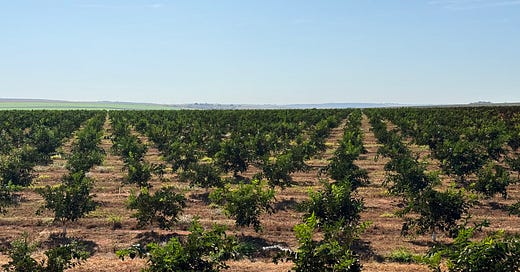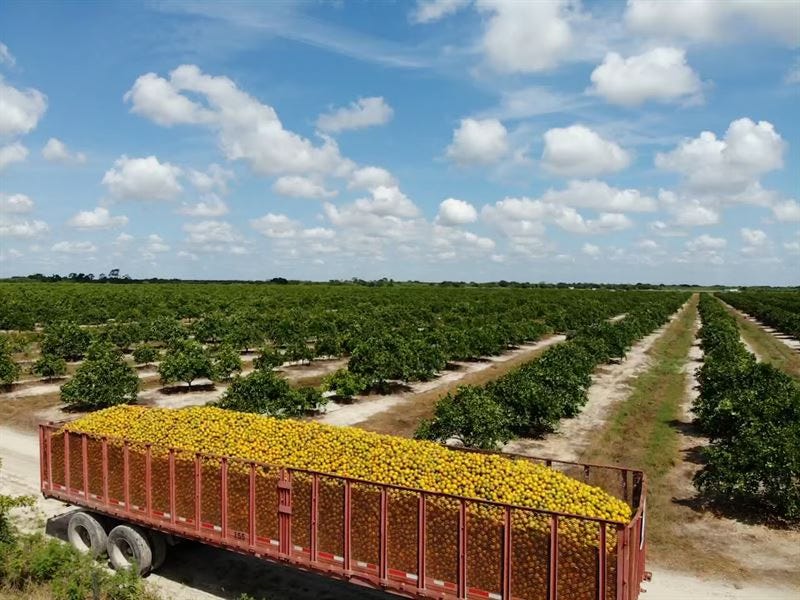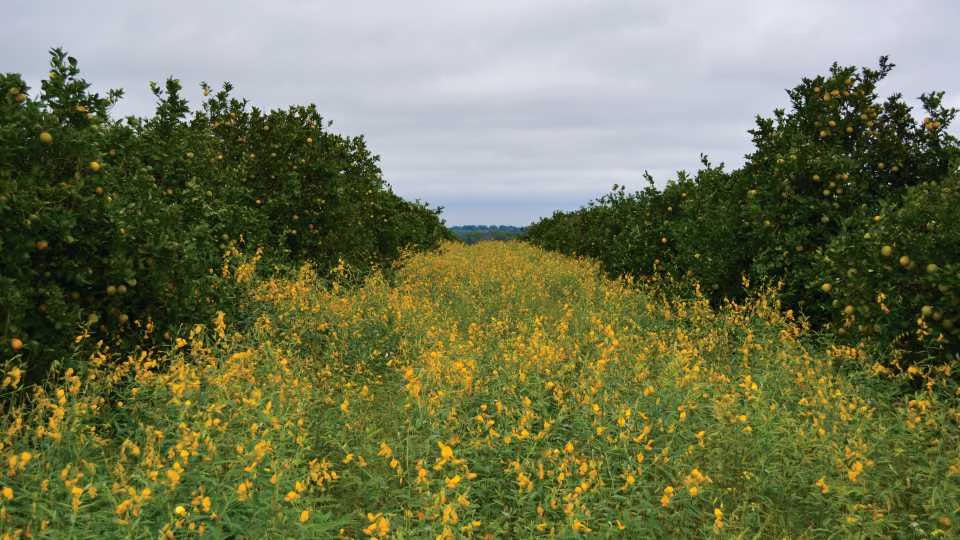Florida's citrus industry, once the crown jewel of American agriculture, has experienced a dramatic decline that serves as a wake up call about the vulnerabilities of industrial monoculture farming. From a peak production of 244 million boxes of oranges in the 1997-98 season, Florida's output has plummeted to a projected 12 million boxes for 2024-25—a 95% decline. This collapse, driven primarily by citrus greening disease (Huanglongbing or HLB) represents one of the most devastating agricultural failures in modern American history. The crisis takes on new dimensions when we understand that decades of soil degradation through chemical-intensive practices created the perfect conditions for disease proliferation.
The Golden Age and Its Hidden Vulnerabilities
At its zenith in the late 1990s, Florida's citrus industry was a marvel of agricultural productivity. The state produced 244 million boxes of oranges in 1998, establishing Florida as the undisputed citrus capital of America. The Commercial Citrus Inventory of 1965 documented 858,082 acres of commercial citrus groves across the state, representing the most intense concentration of citrus production in the world. By 2000-01, Florida was producing 78 percent of total United States citrus, with bearing acreage for oranges, grapefruit, and tangerines totaling 605,000, 108,000, and 42,000 acres respectively.
The great American author John McPhee's 1967 masterpiece Oranges captured Florida citrus at a moment of transition, documenting what he called "the Ridge"—the Florida Divide that served as the state's citrus heartland. McPhee described this geological phenomenon as "the most intense concentration of citrus in the world," a narrow band running from Leesburg to Sebring that was "sometimes as little as a mile and never more than twenty-five miles wide". His prose painted a picture of an industry in full bloom, where groves covered the landscape "like a long streamer" and the air was thick with the promise of endless orange harvests.
Yet embedded within McPhee's observations were subtle warnings about the industry's trajectory. He documented how fresh orange juice was rapidly becoming "a thing of the past," replaced by concentrate production that could transform the fruit of ancient trees into "small, trim cans, about two inches in diameter and four inches high". This early observation would prove prophetic—the same industrial mindset that prioritized efficiency over diversity would later make the industry vulnerable to catastrophic collapse.
What McPhee perhaps couldn't have known was that beneath those flourishing groves, a fundamental transformation was already underway. During the late 1800s and early 1900s, cover crops were widely used in Florida citrus production to enhance soil quality, boost fertility, and manage pests and weeds. These diverse plantings served as critical agricultural tools before the widespread adoption of synthetic fertilizers.
However, during the middle of the 20th century, a dramatic shift occurred. Between 1950 and 1990, the use of cover crops and other organic and biological approaches to control weeds and maintain soil quality in citrus groves nearly disappeared. By 2000, organic fertilizer sources had become virtually non-existent in the industry, accounting for only approximately 0.1% of fertilizers used in Florida citrus production.
This abandonment coincided with the rapid adoption of synthetic fertilizers and herbicides. Following World War II, the industrialization of the Haber-Bosch process led to the widespread availability of synthetic nitrogen fertilizers. Glyphosate, in particular, became central to Florida citrus production after its introduction in the 1970s. Many growers embraced "clean culture"—repeatedly spraying glyphosate between and under citrus trees to maintain bare ground. Research would later reveal that this practice significantly reduced soil organic matter and available nitrogen compared to soils managed with cover crops. More critically, glyphosate's chemical structure allows it to form stable complexes with essential micronutrients—particularly manganese, iron, zinc, and boron—effectively chelating these nutrients and rendering them unavailable for plant uptake. This chelation can inhibit root absorption of manganese and iron by up to 80%, creating deficiencies that weaken trees' natural defense mechanisms against pathogens.
The Perfect Storm
The beginning of the end came in 2005, when citrus greening disease was first detected in Florida's commercial groves. This bacterial infection, spread by the tiny Asian citrus psyllid, has proven to be the most devastating threat in the industry's history. The disease attacks the tree's vascular system, leading to smaller, bitter fruit and eventual tree death. Perhaps most insidiously, once a tree becomes infected, there is no cure—the risk of infection is "high and ultimately unavoidable".
But HLB didn't act alone. The disease found an industry already weakened by decades of ecological degradation. Research indicates that the shift from cover crops and other biological tools to intensive chemical management had significantly impacted soil health in Florida's citrus groves. This degradation was particularly problematic given the inherent challenges of Florida's sandy soils, which naturally have minimal water- and nutrient-holding capacity due to low cation exchange capacity and soil organic matter.
Both the reduction in cover crops and the increase in chemical inputs negatively affected crucial soil microbial communities. Researchers have found that HLB itself decreases the abundance of many soil microbes involved in nutrient cycling, compounding problems with nutrient uptake. HLB-infected trees typically display severe deficiencies in manganese, zinc, iron, phosphorus, calcium, magnesium, and boron—with studies showing approximately 80% lower root manganese concentration and 58% less leaf tissue manganese compared to healthy trees. These micronutrients are critical components of disease defense: manganese powers antioxidant enzymes that combat oxidative stress, zinc maintains cellular integrity and defense gene expression, iron supports growth recovery, and boron synthesizes biochemical defense compounds. Monica Ozores-Hampton, an associate professor at the University of Florida, explains the compounding effect: "The thin soil wasn't an issue before the arrival of citrus greening... But when you have the disease, it really compounds the impact on the trees."
Natural disasters have amplified the industry's woes. The 2004 hurricane season alone saw four major storms reduce crop size and spread citrus canker to previously unaffected areas. More recently, Hurricane Ian in 2022 caused up to $675 million in damages and affected around 375,000 acres of citrus groves. Hurricane Milton in 2024 delivered another devastating blow, affecting "probably 70% of the most productive citrus acreage in Florida" and contributing to what is expected to be the lowest orange crop in a century.
Evidence from the Field: Regeneration in Action
Perhaps the most compelling evidence of the relationship between agricultural practices and disease resilience comes from growers who have successfully reintroduced cover crops and reduced chemical inputs. Edward James provides a remarkable case study. Where his trees were almost dead from HLB, Edward now has almost normal trees with excellent citrus yields. Soil organic matter levels have gone from nearly zero up to a range of 3-5%—levels almost unheard of in hot, sandy Florida soils. Even more significantly, his input costs are now a third of what is typical in citrus. No insecticides are sprayed. No more herbicides to keep the ground bare. Instead, his groves have a vigorous understory of cover crops, many of which are nitrogen-fixing legumes.
The role of micronutrient availability appears central to these successes. Research demonstrates that strategic micronutrient supplementation can significantly improve HLB-affected tree performance. Trees receiving combined foliar and soil-applied micronutrients—particularly manganese at 11.2 kg/ha, iron at 9.6-11.8 kg/ha, and balanced zinc and boron—showed at least 12% increases in canopy volume and improved fruit quality parameters. This approach works by restoring the very nutrients that glyphosate chelation and soil degradation had made unavailable, effectively rebuilding trees' natural defense mechanisms.
Researchers are increasingly documenting the benefits of cover crops for citrus health. A recent study found that mixtures of legumes and nonlegumes increased soil carbon by 25% and soil ammonium, improving overall soil fertility. Cover crops contribute vital micronutrients naturally, avoiding the chelation issues associated with chemical management. Monica Ozores-Hampton’s work found that a simple compost application led to an average 37.8 percent increase in trunk diameter in citrus, which is highly correlated to yields. While compost didn't prevent the disease entirely, it provided larger and healthier root and canopy systems capable of better nutrient uptake.
The devastating impact of citrus greening has sparked a resurgence of interest in cover crops and more sustainable approaches. According to recent research, more peer-reviewed journal publications of cover crops in Florida citrus production have been conducted during the past 4 years than during the previous 60 years combined.
The Cycle Repeats: Brazil's Growing Crisis
As Florida's citrus industry entered its death spiral, Brazil emerged as the world's dominant orange producer. Yet troublingly, Brazil's citrus sector has followed remarkably similar agricultural practices. According to the latest data from Fundecitrus, the average incidence of orange trees with greening in Brazil's Citrus Belt has reached 44.35%, affecting approximately 90.36 million trees—a 16.5% increase from 2023.
The parallels to Florida's experience are unmistakable. Brazilian citrus production relies heavily on glyphosate for weed management, with research revealing concerning usage patterns: 56% of growers use between 1000 and 1500 g ae ha⁻¹, while 11% apply more than 2000 g ae ha⁻¹. Regarding frequency, 47% spray twice per season, 22% spray three times, and 11% spray five or more times—with reports of up to 10 applications annually.
Research has demonstrated that excessive glyphosate use negatively impacts citrus growth and yield in Brazilian orchards, with tree trunk diameter reductions of up to 5.4 cm and fruit yield losses of up to 36.3 t ha⁻¹. Beyond direct toxicity, this creates what researchers call a "vicious and unsustainable circle" where glyphosate's chelation of critical micronutrients—the same manganese, iron, zinc, and boron essential for disease resistance—leaves trees increasingly vulnerable to HLB infection. As herbicide resistance develops, growers apply even higher rates, further degrading soil health and micronutrient availability.
Brazil also faces severe environmental stressors. The country is experiencing its most severe drought since records began in 1950, with drought-affected areas covering 5 million square kilometers—over 58% of Brazil's land area. Combined with extreme heat events, including 11 consecutive days exceeding 35°C in key citrus regions, these conditions mirror the environmental pressures that accelerated Florida's collapse.
Lessons for Industrial Agriculture
Florida's citrus collapse exemplifies the fundamental weakness of industrial agriculture. When vast areas are planted with genetically similar crops that are cut off from essential biological processes, they become extraordinarily vulnerable to pests and diseases. The problem with monocultures is that if an insect likes the crop, that insect has a large food supply to draw from all in one place—essentially creating an endless buffet for plant-eating insects where every dish is delicious.
Monoculture systems disrupt natural ecological balance in ways that extend far beyond immediate crop production. Agricultural monoculture upsets the natural balance of soils by mining soil nutrients and reducing the varieties of bacteria and microorganisms needed to maintain fertility. The production of a single plant species affects soil structure, as only one type of root will be available to capture moisture and build soil organic matter, work that typically requires multiple types of roots.
Research shows that monoculture farming increases vulnerability to climate change impacts. The conversion of biodiverse landscapes to single-species farms alters the water cycle and makes the world more susceptible to ecological instability. This vulnerability has been clearly demonstrated recently in Brazil, where the combination of drought and disease has created a cascade of failures that more diverse agricultural systems might have better weathered.
The Path Forward
Despite the dire circumstances, research continues at institutions like the University of Florida's Citrus Research and Education Center. Scientists are pursuing multiple strategies, including understanding the role of nutrition in citrus greening, improved pest management techniques, and the development of new varieties. Some large and influential citrus companies are seeing the writing on the wall and are now implementing regenerative orchard systems, including cover cropping, integrated pest management, and biological production methods.
The experiences of successful growers like Edward James and others demonstrate that regeneration is possible even in heavily degraded systems. The key lies in understanding agriculture not as a battle against nature but as a partnership with ecological processes. Every percentage point increase in soil organic matter represents approximately 20,000 gallons of water storage capacity per acre—crucial insurance against drought and extreme weather events.
Individual grower success stories, while inspiring, point toward necessary systemic transformation. Research funding must shift from symptom management to systems regeneration. Economic incentives need restructuring to support growers through the transition period to soil-building practices. Knowledge transfer becomes crucial, documenting and disseminating successful regenerative approaches.
A Warning Heeded or Ignored?
Florida's citrus industry collapse serves as one of the most dramatic examples of industrial agriculture's vulnerability in modern American history. From John McPhee's observations in the 1960s of an industry already committed to industrial efficiency over natural diversity, to today's reality of 95% production decline, the story traces a clear arc from prosperity through shortsighted optimization to catastrophic failure.
The lessons are clear: agricultural systems that prioritize short-term efficiency over long-term resilience, that substitute genetic uniformity for diversity, and that disrupt natural ecological relationships do so at enormous risk. The same industrial mindset that allowed Florida to dominate American citrus production for decades ultimately created the conditions for its own destruction.
As other agricultural systems face similar pressures—from erratic climatic patterns, emerging pests and diseases, and the ongoing industrialization of farming—Florida's citrus industry stands as both a warning and a call to action. Brazil's citrus industry, now showing similar infection patterns and following similar agricultural practices, faces a critical choice: continue down the path that led to Florida's collapse or pivot towards an integrated regenerative system before its too late.
The empty groves of central Florida, where McPhee once saw "the most intense concentration of citrus in the world," tell a story that extends far beyond citrus. These empty groves represent the endpoint of an agricultural philosophy that treated farms like factories and ecosystems as expendable. What's most unsettling isn't just what Florida lost, but how each step toward that loss appeared sensible to most at the time.
References:
Martinez, D.A., Loening, U.E., & Graham, M.C. (2018) Impacts of glyphosate-based herbicides on disease resistance and health of crops: a review – Journal: Environmental Sciences Europe, 30(1), 2 – DOI: 10.1186/s12302-018-0131-7
Kanissery, R., Gairhe, B., Kadyampakeni, D., Batuman, O., & Alferez, F. (2019) Glyphosate: Its Environmental Persistence and Impact on Crop Health and Nutrition" Journal: Plants, 8(11), 499 – DOI: 10.3390/plants8110499
Zhang et al. (2017) Huanglongbing impairs the rhizosphere-to-rhizoplane enrichment process of the citrus root-associated microbiome – Journal: Microbiome









Very interesting, but it would be nice to have more citations of your sources!
Seeing agriculture as partnership once again will be so important :)